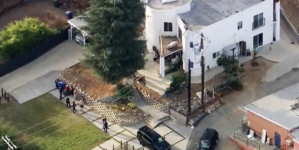-
Padres Acquire Luis Robert Jr. In ‘Fresh Start’ Hypothetical Trade Idea - 13 mins ago
-
Rays vs. Reds Highlights | MLB on FOX - 25 mins ago
-
Kindergarten Pioneer Honored with Four-Day Celebration for 250th Birthday - 48 mins ago
-
Red Sox World Series Champion Drops Blockbuster Trade Prediction For 11-Time All-Star - 52 mins ago
-
Cubs vs. White Sox Highlights | MLB on FOX - about 1 hour ago
-
Vikings’ Justin Jefferson Makes His Feelings Known About JJ McCarthy - 2 hours ago
-
Marlins vs. Brewers Highlights | MLB on FOX - 2 hours ago
-
How to Watch Australia vs British & Irish Lions: Live Stream Rugby, TV Channel - 2 hours ago
-
The Basketball Tournament 2025: Everything to Know Ahead of the Quarterfinals - 3 hours ago
-
India’s New Deals Leave US to Catch Up - 3 hours ago
EPA approves cleanup plan for Monterey County battery plant
Ever since a massive fire tore through one of the world’s largest battery storage facilities in January, cleanup crews have been unable to safely access portions of the building that burned in rural Monterey County.
The risk of reigniting a fire has been too high, preventing crews from starting the lengthy, dangerous removal of tens of thousands of lithium-ion batteries.
Now, that process could soon begin.
The U.S. Environmental Protection Agency announced this week that it had reached an agreement regarding the battery removal with Texas-based Vistra Corp., which owns the battery energy storage system in Moss Landing that caught fire.
The 75-page agreement, signed July 17, requires Vistra to submit detailed work plans to the EPA on all aspects of battery removal and to get the government’s approval before it proceeds.
“Vistra will conduct and pay for the battery removal and disposal process under EPA’s oversight,” Kazami Brockman, the EPA’s on-scene coordinator, said during a Monterey County news briefing Wednesday. “If the agreement is not performed to EPA’s satisfaction, EPA does have the authority to take over the cleanup and bill Vistra for the cost.”
Brockman added, “We anticipate that this work will continue for over a year due to the technical complexity as well as the safety measures being put in place to protect the workers and the community.”
In an email Wednesday night, Meranda Cohn, a Vistra spokeswoman, said “battery removal could not occur until this agreement was in place.”
The Moss Landing fire began Jan. 16. It smoldered for several days, spewing toxic gas into the air and prompting the evacuation of about 1,500 people. Firefighters let it burn, citing the dangers of dousing lithium-ion battery fires with water, which can cause dangerous chemical reactions.
The fire ignited inside a former turbine building that contained a 300-megawatt system made up of about 4,500 cabinets, with each containing 22 individual battery modules, according to Vistra.
Such battery systems store excess energy generated during the day and release it into the power grid during times of high demand, including evening hours. These facilities are seen as essential for stabilizing the state’s electric grid and advancing the transition to cleaner energy because they can store solar and wind power to use when the sun isn’t shining and turbines are not turning.
But the Vistra fire also has exposed the dangers inherent with large-scale battery storage, prompting state and federal regulators to seek stronger safety protocols.
Of the 99,000 individual LG battery modules in the building, about 54,450 burned, according to Vistra.
On Feb. 18, the fire reignited and burned for several hours. Vistra wrote on its website that “additional instances of smoke and flare-ups are a possibility given the nature of this situation and the damage to the batteries.”
The damaged building — filled with burned and unaffected lithium-ion batteries — remains volatile, which has both slowed and complicated the cleanup.
“The challenge here is there are batteries in various states of charge, still being able to hold charge, all the way to completely consumed,” Brockman said.
Over the last six months, crews have removed fire debris containing asbestos and disconnected safely accessible batteries to reduce the risk of reignition, according to the EPA.
A major fire erupted at the Moss Landing power plant on Jan.16, 2025.
(KSBW via Associated Press)
Some portions of the building have been “completely inaccessible,” Ramon Albizu, the EPA’s lead on-scene coordinator, said in an interview Thursday. He added that the 99,000 modules in the building suffered varying degrees of damage.
“We need to carefully, surgically demolish the building to be able to get to all the modules,” Albizu said. “That requires a lot of planning.”
Since the fire, the EPA, Vistra and other regulatory agencies have created more than 30 work plans related to the demolition and battery removal, he said. Work to stabilize the building should begin by the end of the month, he added.
The Moss Landing fire ignited nine days after the start of the deadly Palisades and Eaton fires in Los Angeles County. The EPA, under pressure from the Trump administration to work quickly in Southern California, removed about 300 tons of hazardous household debris — including more than 1,000 lithium-ion batteries — from the massive burn zones in Altadena and Pacific Palisades within 28 days.
Albizu said the battery removal in Moss Landing differs greatly from the removal of smaller batteries in Southern California, many of which came from electric vehicles. In the Vistra building, each of the 99,000 batteries, he said, is about 4 feet long and weighs more than 200 pounds.
“It’s something that is unprecedented,” Albizu said of the battery plant fire.
Once each battery is removed, its remaining energy will be transferred to another source, according to the EPA. If the batteries are too damaged for that to be done, crews will discharge them through brining, during which they are submerged in a water-and-salt solution.
The batteries then will be transported off-site for disposal, David Yeager, director of project development for Vistra, said during the Monterey County news briefing Wednesday.
In a statement to The Times on Thursday, Monterey County Supervisor Glenn Church, whose district includes Moss Landing, said he was “disappointed it has taken this long to come to a point where cleanup can begin, but safety must be a priority.”
According to Vistra, the cause of the blaze “remains unknown” and is still under investigation by the company. The California Public Utilities Commission also has an ongoing investigation.
The Vistra fire rocked California’s clean energy industry and its plans for more battery plants, which state leaders are aggressively pursuing.
In an op-ed for the Wall Street Journal published Wednesday, Gov. Gavin Newsom touted California’s transition to renewable energy, writing that it was “time for America to follow California’s lead.”
He wrote that the ability to store clean electricity was “a key factor” in hitting clean energy goals and that, over the last six years, the state has added 15,000 megawatts of battery storage capacity, enough to meet a quarter of peak electricity demand.
“More is on the way,” Newsom wrote, “including the largest battery project in the world, now being permitted in Fresno County through California’s new fast-track permitting process.”
Along with additional safety regulations for battery storage, the blaze has prompted calls for more local control over where storage sites are located.
In a survey of nearby residents conducted by the Monterey and Santa Cruz counties’ health departments, 83% of respondents said they experienced at least one symptom — most commonly headaches, sore throats and coughing — shortly after the fire. Nearly a quarter of respondents said they had trouble breathing, and 39% reported having a metallic taste in their mouth.
The survey, conducted in February and March, polled 1,539 people who lived or worked in the region at the time of the fire.
Knut Johnson, an attorney with the law firm Singleton Schreiber, said hundreds of nearby residents have joined a lawsuit against Vistra, LG Energy Solution and Pacific Gas & Electric, accusing the companies of failing to maintain adequate fire safety systems.
Johnson said plaintiffs are “very worried” about the batteries that remain on site.
“Those burned-up batteries still contain a lot of toxins,” Johnson said. “The wind blows, the evening fog rolls in, suspending particles in the moisture — there’s lots of ways for any remaining toxins to get around the community.”
The fire should “serve as a wake-up call,” Johnson said, for anyone wanting to build battery storage facilities near residential areas and sensitive ecosystems.
Source link































